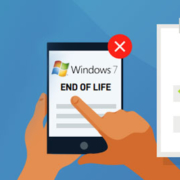How nonprofits can get the most out of their managed service provider
The emergence of new technologies such as cloud computing, blockchain, AI, and robotic process automation forces more and more organizations to digitize their processes. For most institutions, adopting and implementing new technologies is no longer an option but a necessity. The year-over-year growth of the digital transformation market is evidence of this trend.
However, non-profits generally fall behind in adopting new technologies. Top non-profit organization leaders agree that most non-profits are behind the curve in digital transformation, one of the main challenges facing this sector today.
One of the ways that nonprofits can close this digital divide is by partnering with a managed services provider (MSP) to accelerate and facilitate IT adoption. And many have already done so. However, you have to be diligent to get the most out of an MSP. Here are a few tips for doing just that:
Ensure that you’re working under the correct service model
Most MSPs have more than one service package. These are usually tiered based on the scope of service to suit different organizations or IT infrastructures. So, be careful when selecting the service model for your non-profit. First, analyze your IT and find out what’s missing—it could be skilled labor, cybersecurity, or modern tech solutions. Then consult with the MSP to determine the most suitable managed services package to meet all your requirements. Depending on the MSP’s flexibility, you could even customize a unique service model just for your organization.
Avoid break-fix IT support
Some managed services providers still offer the traditional break-fix IT support model. In this scenario, you only pay for the services rendered, usually at an hourly rate. For instance, if a server goes down, you simply call and pay the MSP to fix it.
It’s easy to get lured by the potential cost saving of the break-fix model. But these savings quickly evaporate when something goes terribly wrong and takes a lot of time and cash to fix. Plus, there is no way to prevent systems from crashing or unwanted downtime. A proactive IT support approach would be much more economical and practical in the long run.
Build a close relationship with your MSP
Think of your MSP as a partner rather than a replacement for your staff or a third-party contractor. Build this partnership on a solid relationship based on communication and trust. Most MSPs offer advisory and consultation services; take advantage of these to express your organization’s goals and bring the MSP on board to help you achieve them. Position your MSP as a growth partner that empowers your efforts through tech innovations.
Resist the urge to bargain shop
One of the main reasons that organizations outsource IT services is to cut operational costs. So, it makes sense to go for the cheapest options, right? Well, MSP pricing is not that simple. In most cases, price does not determine the service’s quality but its scope. For instance, a low-price package might lack some essential, premium, or value-added services.
Basing your choice of MSP on price alone can be misleading. Some MSPs will lure you with low prices and still end up costing you more than a higher-priced alternative down the road. Instead of looking at the price tag, consider what the provider has to offer and their reputation, competence, and experience in the industry.
Managed IT services can do a lot for your non-profit, provided you choose the right MSP and service package. Go for a service provider who’s willing and able to help your organization navigate dynamic IT challenges with a strong emphasis on growth. GDR Group is one such MSP. We go well beyond the day-to-day IT support services to ensure that your organization reaches new heights with robust digital solutions. Contact us and transform your non-profit to reach donors, supporters, and courses in new ways.










